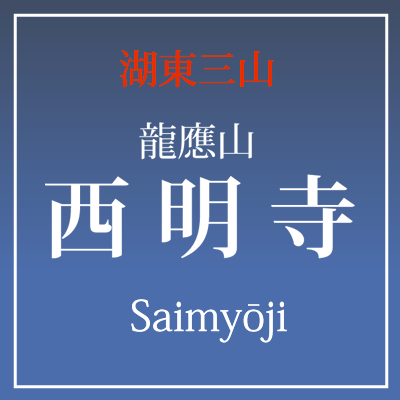Welcome to Saimyōji Temple
The Saimyōji Temple Brief History
The temple Saimyōji was founded in 834, during the Heian period (794–1185), by the holy priest Sanshū at the imperial command of the emperor Nimmyō. It flourished throughout the Heian, Kamakura, and Muromachi periods (eighth through sixteenth centuries) as a place of prayer and training for the search for enlightenment and is said to have included 17 Buddha halls and 300 priestsʼ lodgings. According to tradition, the shogun Minamoto no Yoritomo once visited the temple to pray for victory in battle.
During the Warring States period (1467–1568), immediately after burning the temple Enryakuji, on Mount Hiei, the warlord Oda Nobunaga set fire to the Saimyōji as well. Fortunately, however, the main hall (Japanʼs first designated national treasure), the three-story pagoda, and the Nitenmon gate escaped the conflagration to survive to the present.
During the Edo period (1603–1868), owing to the efforts of high priests Tenkai and Kōkai, the lord Mochizuki Etchū no Kami Yūkan restored the Saimyōji as a temple for prayer and training.
Architecture
Main Hall(Ruriden): Designated National Treasure
Built by master carpenters of the Hida region in the early part of the Kamakura period (1185–1333), the Main Hall is in the pure Japanese architectural style. No nails are used in its construction. It is roofed with Japanese-cypress-bark shingles and preserves examples of such Kamakura-style architectural features as the so-called frog-leg carved wooden supports and distinctive lattice patterns.
Three-story Pagoda: Designated National Treasure
Built by master carpenters of the Hida region in the late part of the Kamakura period (1185–1333), the pagoda, which is in the pure Japanese architectural style, is made entirely of Japanese cypress (hinoki) and employs no nails. It is roofed with Japanese-cypress-bark shingles.
The walls of the first level are covered in murals by painters of the Kosè school illustrating the Lotus Sutra (Hokekyo), the 32 bodhisattvas attendant on Vairocana Buddha (Dainichi Nyorai), and hosoge floral arabesques, all in brilliant colors. They are said to be the only Kamakuraperiod murals in the country. (Pagoda height: 23.7 meters.)
Nitenmon Gate: Designated Important Cultural Property
Temple Treasures
Honzon Yakushi Nyorai (Principal Image: Buddha of Medicine and Healing): Designated Important Cultural Property, Heian period (794–1185)
Shaka Nyorai (Shakyamuni Buddha): Designated Im portant Cultural Property, Kamakura period (1185–1333)
Fudō Myō-ō (Acala) and two dōji (attendant boys): Designated Important Cultural Property, Heian period (794–1185); attributed to Chishō Daishi
Nitennō-Komoku-ten and Tamon-ten (two of the Four Guardian Kings): Designated Important Cultural Property, Heian period (794–1185)
Nikkō Bosatsu and Gakkō Bosatsu (Bodhisattvas of Solar and Lunar Radiance): Designated Municipal Cultural Property, Kamakura period (1185–1333)
Juni Shinshō (Twelve Divine Generals): Designated Prefectural Cultural Property, Kamakura period (1185–1333); attributed to a disciple of the famous sculptor Unkei
Sanzon Amida Nyorai (Amida Triad): Designated Municipal Cultural Property, Kamakura period (1185–1333); attributed to Anami (Kaikei)
Statue of the High Priest Gansan Daishi: Designated Municipal Cultural Property, Muromachi period (1336–1573)
Statue of the Buddhist Goddess Benzaiten: Designated Municipal Cultural Property, Muromachi period (1336–1573)
Many other examples of Buddhist sculpture.
Other Highlight
Scenic garden: Hōrai Tei : Designated National Garden
The garden features standing stones representing the Yakushi-Buddha Triad–Yakushi Nyorai and the Nikkō and Gakkō bodhisattvas–as well as a stone grouping representing the Twelve Divine Generals. One of the islands in the Shinji-ike Pond represents an origami crane; another represents a tortoise. The garden also features a lantern by Ishiya Midaroku.
Natural Monument: Saimyōji Fudanzakura Cherry Tree: Prefectural Cultural Property
Annual Events
| 毎月8日 The 8th day of each month |
Yakushi Goma Ceremony |
| 1月8日 January 8 |
First Yakushi Grand Hannya Ceremony (Hatsu Yakushi Dai Hannya-E) |
| February 3 | Setsubun Festival (Setsubun-E, the Day Before the Beginning of Spring Ceremony) |
| May 8 | Anniversary of the Buddhaʼs Birth (Bussho-E) |
| August 18 | Day of Appreciation for the Bodhisattva Kannon |
| September 8 | Yakushi Nyorai Festival Day (Yakushi Nyorai En-nichi-E) |
| December 8 | Perpetual Sutra Chanting (Eitaikyokuyō) |
Access
By Train
By sightseeing taxi to the Saimyōji from the Kawase, Hikone, or Maibara stations on the JR line.
By Car
Take the Meishin Expressway to the “Kotō-sanzan Smart IC” or the “Hikone IC” then change to Route 307.
